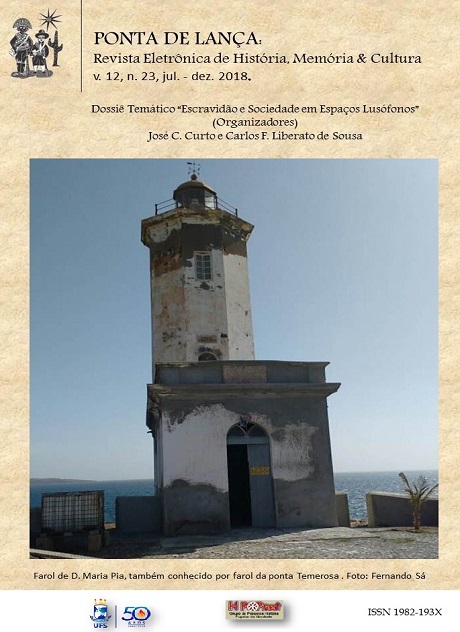The Population of the Lower Kwanza Valley, 1792-1796
Resumo
Este trabalho baseia-se numa fonte quantitativa pouco explorada, a “Convenção dos Dízimos”. Esta documentação contém características demográficas das populações que habitaram o vale do baixo Kwanza em meados da década de 1790 e foi produzida pouco antes dos recenseamentos nominais e sumários começarem a serem feitos nas áreas que compunham essa região. Compilado entre 1792 e 1796 pelo Capitão Francisco António Pita Bezerra de Alpoim e Castro, esse documento representa um censo regional cuja informação era para funcionários coloniais melhorar a extração de impostos entre as populações de Ambaca, Pundo Andongo, Cambambe, Massangano, Muxima e Calumbo. Esses territórios formavam um corredor através do qual anualmente passavam milhares de cativos destinados em grande parte para as Américas, especialmente o Brasil. Oferecendo o mais antigo perfil do tamanho, gênero, grupos etários e distribuição geográfica das populações que habitavam os territórios supracitados, a “Convenção dos Dízimos” não só permite obter uma melhor compreensão da produção de dados demográficos na Angola colonial, como também possibilita um refinamento, se não a correção, de certas noções relativas ao impacto do comércio de escravos no Atlântico.
Palavras-Chaves: história demográfica, Angola, recenseamentos
Downloads
Referências
BIRMINGHAM, David. Trade and Conflict in Angola: The Mbundu and their Neighbours under the Influence of the Portuguese, 1483-1790. Oxford: Clarendon Press, 1966.
CASTELLO BRANCO E TORRES, João C. F. C. De. Memórias Contendo a Biographia do Vice Almirante Luis da Motta Feo e Torres, a História dos Governadores e Capitães Generaes de Angola desde 1575 até 1825, e a Descripção Geographica e Politica dos Reinos de Angola e Benguella. Paris: Fantin, 1825.
CASTRO FRANCINA, Manuel Alves de. Itinérario de uma jornada de Loanda ao districto de Ambaca na provincia de Angola. Annaes do Conselho Ultramarino – Parte Não Official, 1ª série, 1854, p. 3-15.
CURTO, José C. Rethinking the origin of slaves in West Central Africa. In: WELDEMICHAEL, Awet T.; LEE, Anthony A; ALPERS, Edward A. (eds.). Changing Horizons of African History. Trenton, NJ: Africa World Press, 2016, p. 23-47.
CURTO, José C. Whitening the ‘white’ Population: An Analysis of the 1850 censuses of Luanda. In: PANTOJA, Selma; THOMPSON, Estevam C. (eds.). Em Torno de Angola: Narrativas, Identidades, Conexões Atlânticas. São Paulo: Intermeios, 2014, p. 225-247.
CURTO, José C. The Anatomy of a Demographic Explosion: Luanda, 1844-1850. International Journal of African Historical Studies. v. 32, 1999, p. 381-405.
CURTO, José C. Sources for the Pre-1900 Population History of Sub-Saharan Africa: The Case of Angola, 1773-1845. Annales de Demographie Historique. 1994, p. 319-338.
CURTO, José C. Demografia Histórica e os Efeitos do Tráfico de Escravos em África: Uma Análise dos Principais Estudos Quantitativos. Revista Internacional de Estudos Africanos. nos. 14-15 1991, p. 243-277.
CURTO, José C.; GERVAIS, Raymond R. The Population History of Luanda During the Late Atlantic Slave Trade, 1781-1844. African Economic History. v. 29, 2001, p. 1-59.
DOMINGUES DA SILVA, Daniel B. The Atlantic Slave Trade from West Central Africa, 1780-1867. New York: Cambridge University Press, 2017.
DOMINGUES DA SILVA, Daniel B. The Early Population Charts of Portuguese Angola, 1776-1830: A Preliminary Assessment. Anais de História de Além-Mar. v. 16, 2015, p. 107-124.
DOMINGUES DA SILVA, Daniel B. The Transatlantic Slave Trade from Angola: A Port-by-Port Estimate of Slaves Embarked, 1701-1867. International Journal of African Historical Studies. v. 46, 2013, p. 105-122.
ELTIS, David. Nutritional trends in Africa and the Americas: heights of Africans, 1819-1839. Journal of Interdisciplinary History. v. 12, 1982, p. 453-475.
ELTIS, David; ENGERMAN, Stanley L. Fluctuations in Sex and Age Ratios in the Transatlantic Slave Trade, 1663-1864. Economic History Review. v. 46, 1993, p. 308–323.
ELTIS, David; BEHRENDT, Stephen; RICHARDSON, David; KLEIN, Herbert S. The Atlantic Slave Trade: A Database on CD-Rom. Cambridge: Cambridge University Press, 1999.
ELTIS, David; et al. “Voyages: The Trans-Atlantic Slave Trade Database.” Disponível em <http://www.slavevoyages.org>.
ELTIS, David; RICHARDSON, David. Atlas of the Transatlantic Slave Trade. New Haven: Yale University Press, 2010.
FREUDENTHAL, Aida; PANTOJA, Selma. (eds.). Livro de Baculamentos Que os Sobas deste Reino de Angola pagam a Sua Majestade 1630. Luanda: Ministério da Cultura, 2013.
GUEDES, Roberto. Branco africano: notas de pesquisa sobre escravidão, tráfico de cativos e qualidades de cor no Reino de Angola (Ambaca e Novo Redondo, finais do século XVIII). In: GUEDES, Roberto (ed.). Dinâmica imperial no Antigo Regime português. Rio de Janeiro: Mauad X, 2011, p. 19-33.
GUTIÉRREZ, Horácio. O tráfico de crianças escravas para o Brasil durante o século XVIII, Revista de História, São Paulo. v. 120, 1989, p. 59-72.
HEYWOOD, Linda; THORNTON, John K. African Fiscal Systems as Sources for Demographic History: The Case of Central Angola, 1799-1920. Journal of African History. v. 29. 1988, p. 213-228.
KLEIN, Herbert S. The Portuguese Slave Trade from Angola in the 18th Century. Journal of Economic History. v. 32, 1972, p. 849-918.
LOPES DE LIMA, José J. Ensaios Sobre a Statistica das Possessões Portuguezas do Ultramar. Lisbon: Imprensa Nacional, 1846. v. III.
LOVEJOY, Paul E. Transformations in Slavery: A History of Slavery in Africa. New York: Cambridge University Press, 2012 [1983].
LOVEJOY, Paul E. The Children of Slavery: The Transatlantic Phase. Slavery and Abolition. v. 27, 2006, p. 197–217.
MANNING, Patrick. Slavery and African Life: Occidental, Oriental, and African Slave Trades. New York: Cambridge University Press, 1990.
MILLER, Joseph C. Way of Death: Merchant Capitalism and the Angolan Slave Trade, 1730-1830. Madison: University of Wisconsin Press, 1988.
OMBONI, Tito. Viaggi Nell’Africa Occidentale: Gia Medico de Consiglio Nel Regno d’Angola e sue Dipendenze Membro della R. Accademia Peloritana di Messina. Milan: Civelli, 1845.
SILVA CORRÊA, Elias Alexandre da. História de Angola. Lisbon: Editorial Ática, 1937. 2 v.
TEODORO DE MATOS, Paulo; VOS, Jelmer. Demografia e relações de trabalho em Angola c.1800: um ensaio metodológico. Diálogos. v. 17, 2013, p. 807-834.
THORNTON, John K. The Demographic Effect of the Slave Trade on Western Africa, 1500-1850. In: Fyfe, C.; McMaster, D. (eds.). African Historical Demography, II: Proceedings of a Seminar Held in the Centre of African Studies, University of Edinburgh, 24th and 25th April, 1981. Edinburgh: University of Edinburgh, Centre of African Studies, 1981, v. II. p. 691-720.
THORNTON, John K. The Slave Trade in Eighteenth Century Angola: Effects on Demographic Structures. Canadian Journal of African Studies. v. 14, 1980, p. 417-427.
THORNTON, John K. An Eighteenth Century Baptismal Register and the Demographic History of Manguenzo. In: Fyfe, C.; McMaster, D. (eds.). African Historical Demography, I: Proceedings of a Seminar Held in the Centre of African Studies, University of Edinburgh, 29th and 30th April, 1977. Edinburgh: University of Edinburgh, Centre of African Studies, 1977b, v. I, p. 416-428.
THORNTON, John K. Demography and History in the Kingdom of Kongo, 1550-1750. Journal of African History. v. 18, 1977a, p. 507-530.
VANSINA, Jan. Ambaca Society and the Slave Trade c. 1760-1845. Journal of African History. v. 46, 2005, p. 1-27.
VENÂNCIO, José C. Espaço e Dinâmica Populacional em Luanda no Século XVIII. Revista de História Econômica e Social. v.14, 1984, p. 67-97.
VOS, Jelmer. Work in Times of Slavery, Colonialism, and Civil War: Labor. Relations in Angola from 1800 to 2000. History in Africa. v. 41, 2014, p. 363-385
Downloads
Publicado
Como Citar
Edição
Seção
Licença
Os autores devem concordar com os termos da Declaração de Direito Autoral, que se aplicará a submissão caso seja publicada nesta revista, assim como, repassa a Revista Ponta de Lança como detentora dos direitos autorais da publicação.
- As opiniões expressas nos textos submetidos à Ponta de Lança são da responsabilidade dos/as autores/as.
- Autores/as conservam os direitos de autor/a e concedem à revista o direito de primeira publicação, com o trabalho simultaneamente licenciado sob a Licença Creative Commons Attribution que permite a partilha do trabalho com reconhecimento da autoria e publicação inicial nesta revista.
- Os/As autores/as comprometem-se a seguir as “Normas para submissão de manuscritos”, na plataforma.
- Sempre que o texto precisar de sofrer alterações, por sugestão dos/as Revisores/as Científicos e/ou da Comissão Executiva, os/as autores/as comprometem-se a aceitar essas sugestões e a introduzi-las nas condições solicitadas. Sempre que houver alterações de que os/as autores/as discordem, devem ser apresentadas as respectivas justificações, caso a caso.
- A reprodução de material sujeito a direitos de autor/a foi antecipadamente autorizada.
- Os textos são originais, não publicados nem submetidos a outras revistas.
Licença Creative Commons Atribuição-NãoComercial 4.0 Internacional (BY-NC-4.0)
















 Licença
Licença 